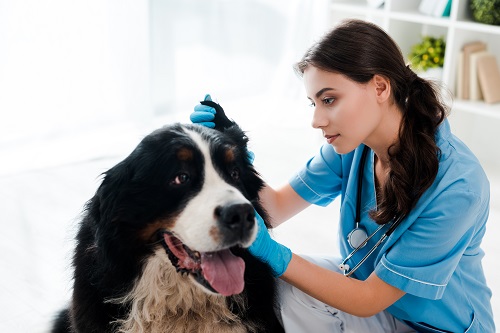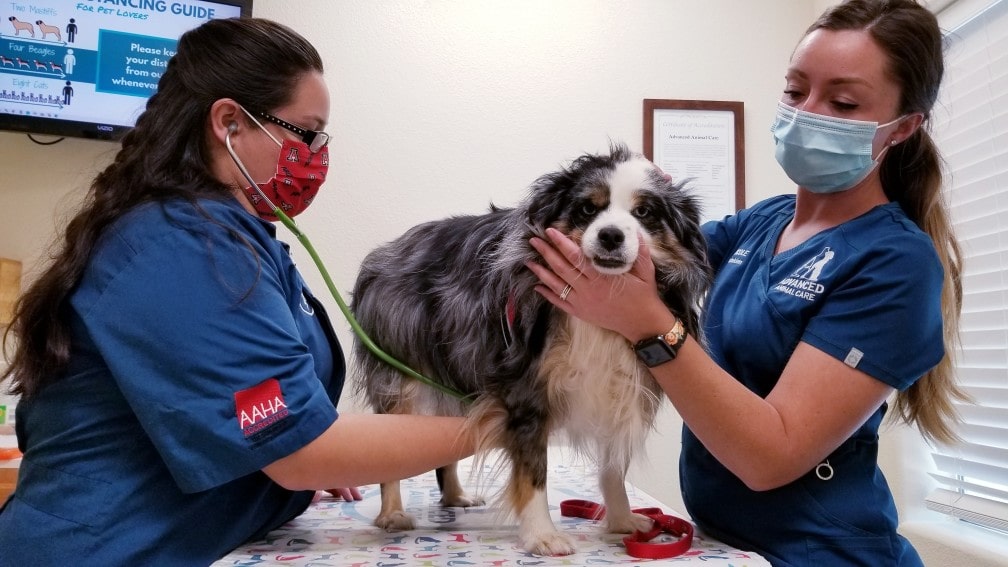Do you know that most dogs suffer from some common diseases that can be susceptible and get treated if found early? These common diseases may include several infections, allergies, indigestion, etc.
Did you also notice any signs of these diseases in your dog? If so, you need to get your dog the treatment as early as possible since it may lead to a severe health issue if it remains unnoticed.
The Most Common Diseases in Dogs
Here is a list of the most common dog diseases that may remain unnoticed by you if you don’t consider the symptoms:
1. Gastric Torsion, a.k.a. Bloat
Does your dog like to gulp down food without chewing? If yes, then he may be at risk of Gastric torsion. It is an enlarged stomach. It can become troublesome if the stomach turns. If this happens, then fluid and air don’t get to escape, and the dog cannot vomit the food out.
Symptoms:
- Retching and the inability to vomit
- Restlessness
- Salivating
- Enlarged stomach area (extended and sensitive to touch)
Bloat is one of those dog diseases that can affect any dog at any age, but a few breeds are more susceptible to it, such as Great Danes, German shepherds, Boxers, Labrador retrievers, Bloodhounds, and Weimaraners. In addition, mid-size dogs such as Basset hounds and Dachshunds are also susceptible to this disease.
Prevention
The best way to prevent this disease is to train your dog to eat slowly. There are many ways, such as putting the food in a deep bowl and letting the dog work for it. This prevents the dog from inhaling the food. Thus it is decreasing the chances of Bloat.
2. Parvovirus a.k.a. Parvo

Parvovirus is a part of the core vaccines that all puppies should be given. This is one of the viral dog diseases that usually attacks the dog’s intestines and heart. Most puppies in the breeding facilities are at a higher risk. This disease usually spreads if a dog comes in contact with the poop of a contaminated dog. However, this disease is preventable with vaccination at an early age.
Symptoms
- Severe diarrhea
- Weight loss
- Vomiting
Treatment
Parvo is hugely preventable by vaccination. So, getting your puppy all the core vaccinations is imperative! However, if your dog does contract this disease, supportive care is the only option, along with a few medications to tone down the effects of the disease.
3. Kidney Disease, a.k.a. Renal Failure
It is one of the most common dog diseases and can happen to a dog over time or from a complication from medications for other diseases. A chronic kidney disease that occurs over time is not preventable (most of the time).
Usually, dogs with a genetic susceptibility towards kidney failure are at higher risk. Therefore, it is very important to check your pet’s parent’s medical history before getting the pet. Acute kidney disease, on the other hand, is largely preventable.
Symptoms
- Vomiting
- Fatigue
- Constipation
- Increase in thirst
- Depression etc.
- Fever
- Frequent urination
Prevention
Chronic kidney disease that’s caused by the dental disease can be prevented. In the advanced stages of this disease, bacteria from the dog’s gums can enter its bloodstream and damage vital organs such as kidneys. It can be prevented by keeping your dog’s teeth clean. You can offer chew sticks or chew toys to remove plaque from your dog’s teeth.
Acute kidney disease can be caused due to poisoning, infection, or complication from other medications. To prevent acute kidney disease, keep human medications and toxic substances away from your dog.
4. Fungal Diseases

These dog diseases spread via air. They are usually present in the soil; if your dog inhales that contaminated soil, he can contract a fungal disease. Not all fungi diseases are fatal. However, some affect the entire body, like the liver, lungs, brain, etc., and are fatal.
Two most serious fungi diseases:
- Valley Fever: It is the most serious and life-threatening fungi disease. If they are released into the air where dogs can inhale, they will experience severe respiratory symptoms, such as shortness of breath, lung collapse, etc. This deadly disease can only be prevented by keeping dogs away from unknown areas.
- Blastomycosis: This is another serious fungal disease. This fungus lives in soil sheltered from the sun and is mostly found around damp areas along riverbanks, lakes, and swamps. Symptoms typically include difficulty breathing, skin lesions, and loss of appetite. To prevent this, keep your dog away from damp soil within 400 meters of a body of water. Large-breed male dogs, who like to dig, are at higher risk!
5. Chocolate Poisoning
Chocolate poisoning is one of the most common causes of poisoning in dogs. Most people feed chocolates to their dogs and believe it doesn’t hurt them. However, if you have a small dog like a pug, a single piece of dark chocolate can cause severe food poisoning.
The two main issues are the amount your dog eats and the type of chocolate. You have to keep in mind that chocolates are poisonous to dogs. Period!
Symptoms
- Vomiting
- Diarrhea
- Panting
- Irregular heartbeat
- Seizures
More serious cases can cause heart attack and even death. If you think your dog has eaten chocolate, immediately take him to the doctor. Chocolate poisoning symptoms can last up to 72 hours. Use PetMD’s chocolate toxicity meter to gauge your dog’s level of poisoning.
6. Arthritis
Arthritis is a term used for abnormal joint differences, a common dog condition. It is the major cause of chronic pain and can cause permanent joint damage, especially in older dogs. It usually affects the joints like hips, knees, shoulders, and elbows.
If you notice your dog getting slower onto its feet and it seems less active than it used to be, it probably suffers from arthritis. However, your dog may hide its pain and discomfort, particularly in the early stages, even if it is very painful.
7. Cataracts

A cataract is an opacity or cloudiness of the lens that prevents rays from getting to the retina, which results in vision impairment. Cataracts can arise in both eyes and may progress slowly or rapidly.
Some signs to help you see if your dog is suffering from a cataract include a whitish, blue, or a gray area in the center of the eye and behavioral changes relating to decreased sight.
It can be difficult for you to observe very soon as dogs can use their senses of hearing and smell to hide their vision loss. Usually, cataracts are found in old dogs; however, they may also develop in a newly-born dog or after a few weeks after the eye has been through trauma or can be caused by disease.
8. Ear Infections
Another very common disease in dogs is an ear infection, especially in breeds with long ears that spend most of their time outside. Usually, when wandering your dog outside, it may get dirt, dust, or some other particle like a grass seed inside the ear, which may cause irritation and infection.
You can learn if your dog has an ear infection if they’re pawing at their ears and shaking heads. Ears infected may be red or crusty and produce a discharge or odor.
Read Also: Dog Ear Infection – How to Identify, Treat, and Prevent
9. Kennel Cough
Kennel cough is a common illness among dogs, mostly in crowded conditions like at the animal shelter, vet, or pet accommodation. It is a highly infectious illness that spreads over various areas easily via droplets in the air or contact with any contaminated surface such as water, food bowl or touches with another dog.
However, it can sound bad, equivalent to the standard cold, and is not usually life-threatening. The most useful way to cure it is by giving them proper rest, food, and water. Also, you may give antibiotics after asking your vet if your dog’s case is particularly severe.
10. Fleas and ticks
Fleas are a typical parasite faced by almost every dog during a lifetime. It jumps from one host to another, and your dog may also pick them by contacting infected animals. It can cause severe itching all over your dog’s body, even if they’ve got only one flea.
Scratching, pawing, and licking the bites while relieving itching can lead to inflammation, infection, and even hair loss. However, with the right medication and proper treatment, you can help your dog to eradicate fleas easily with several products from any pet store, as suggested by your vet.
However, ticks are far more serious and are usually common on the east coast of Australia between August and February and can cause serious problems in a dog, like blood poisoning and death. Dogs are likelier to pick a Paralysis Tick, especially outdoor animals interacting with wildlife or bushy or grassy areas.
Read Also: 12 Natural Ways to Prevent and Get Rid of Fleas on Dogs
11. Diarrhea
Diarrhea is largely common in dogs that feel like frequent liquid or loose bowel movements and can be brought by several causes, both serious or just a sensitive stomach. It may also develop dehydration in your dog in more severe cases, leading to serious health problems like exercise intolerance, weakness, collapse, and seizures.
In several cases, diarrhea will decrease with time if your dog gets a good diet and plenty of rest. However, another symptom of chronic diarrhea may be an underlying illness like inflammatory bowel, infections, kidney or liver disease, or even cancer. You should immediately take your dog to a vet if the condition persists for over a week.
12. Heartworm
Heartworms are parasitic worms that grow and live in an animal’s heart or lungs. Heartworm infestations will evolve over many years before you can see any serious symptoms in your dog’s behavior, which is often life-threatening.
In recent periods, heartworms were a common parasite that affected dogs, but modern medications prevent cases from happening. Vets often suggest blood tests and fecal tests annually to keep a check on conditions that could be present.
13. Obesity
Another condition amongst dogs that aren’t taken seriously is obesity. It is one of the major causes of long-term illness in dogs. If your dog is overweight, it might risk developing conditions like heart disease, arthritis, kidney disease, etc. But fortunately, it is believed that almost all dogs suffering from obesity can be cured by taking control of their diet and exercise regime.
14. Bone fractures

A bone fracture or break can be caused by abnormal stress, usually from a traumatic incident such as being struck by a car or falling from a height. Your dog can avoid its pain, so it is your responsibility as an owner to watch for limping, lumps, or bones protruding from the skin, whimpering, or whining if touched.
Fractures are usually relatively simple to treat, while others can be complex, including surgery to realign bones and immobilize limbs to heal, ease pain and prevent further damage. Usually, bone fractures take a few weeks to heal, which can restrict your dog’s physical activity and require physical therapy to assist with restoration.
15. Cancer
Lastly, canine cancers are becoming common nowadays and are on the rise. It is shocking to note that approx. 50% of old age dogs develop some form of cancer. It is the leading cause of death in older dogs. The faster you find and treat cancer, the better the chance of survival.
Symptoms
- Lumps on the skin
- Weight loss
- Change in appetite
- Lethargy
Lymphoma is the only cancer type that is treatable. It is also one of the most common canine cancers. Don’t forget to get your senior dog checked regularly after age 10.
Note: Genetics and environmental factors also play a key role in cancer development. A healthy environment, and routine, along with good food, can reduce the chances of cancer to a drastic level in senior dogs.
Conclusion
As a dog owner, you must pay close attention to behavioral changes in your dog that may indicate its discomfort. These common diseases are usually not serious and are eradicable if they are timely diagnosed and treated properly.
However, having your furry friend regularly visit the vet to check their medical condition and discuss any doubts about their health would be best. You can also talk to the vet about any concerns or behavioral or feeding habit changes.
FAQs
Que: How do you know if my dog being sick is serious?
Ans: If your dog suffers from repeated vomiting or diarrhea lasting more than two days, you should immediately consult with or take your dog to the vet. Even if it is no longer sick, contact the vet if you see a difference in eating or feel depressed or lethargic.
Que: What is the main dog illness?
Ans: Among the common illnesses, dogs may develop ear infections, kennel cough, ringworm, etc. Dogs, no matter of age, can suffer from various medical problems. Therefore, owners should learn about common conditions and ways to spot and get treated.
Que: How do you know if my dog is in pain?
Ans: You can check for some of the most common general behaviors in your sick dog like shaking, low posture, flattened ears, aggression, panting or crying, grumpy temperament, excessive licking, reluctant to play, interact or exercise, scratching a specific area lameness (limping), stiffness after rest and loss of appetite.
Que: What are the common causes of pain in dogs?
Ans: Dogs often feel pain for several similar reasons as humans: infections, dental problems, bone disease, arthritis, and cancer. They also suffer from discomfort through surgical procedures as humans do; however, they can’t speak but show some signs when they hurt.

 DogExpress
DogExpress





























 in Chandigarh, India.
in Chandigarh, India. 
